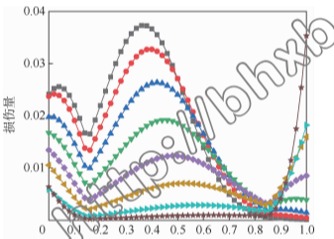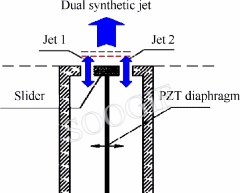-

Size of cement concrete pavement slab of airport runway
ZHANG Xianmin, LI Mengxiao, CHEN Yu, LI Changhui, XU Boqing
doi:doi: 10.13700/j.bh.1001-5965.2020.0646
 Abstract
AbstractChinese airports usually use cement concrete road slabs with a slab width of no more than 5 m, and existing airports in other countries use cement concrete slabs with a width more than 6 m. Small size cement concrete pavement slabs are more likely to suffer from disease than large size. In order to study the effect of pavement slab size on pavement performance, a finite element model of pavement structure was established based on the elastic layered theoretical system. By changing the size of the pavement slab, the stress changes of the pavement slab under the combined action of aircraft load and temperature gradient are studied. The internal stress change of the slab is used to analyze the influence of the plane size of the pavement slab on the service life of the pavement slab under the combined action of temperature gradient and aircraft load through an example of real airport.
-

Stability characteristics and arworthiness requirements of blended wing body aircraft with podded engines
Lixin WANG,Ning ZHANG,Hailiang LIU,Ting YUE.
doi:https://doi.org/10.1016/j.cja.2021.09.002
 Abstract
AbstractBlended-Wing-Body (BWB) aircraft have a relatively short fuselage and no horizontal tail, and they usually adopt podded engines and a V tail instead of a vertical tail. Generally, BWB aircraft have decreased longitudinal and directional static stability and damping. In this paper, the three-axis static and dynamic stability characteristics of an example BWB aircraft with podded engines are studied. According to the differences in flight characteristics of BWB aircraft and conventional aircraft, the different airworthiness requirements for BWB aircraft are analyzed: first, based on current airworthiness regulations and transport aircraft flying quality specification, the relaxation requirement of longitudinal static stability for BWB aircraft is studied; second, the influences of podded engines on longitudinal trim, attitude and trajectory responses and maximum directional control power requirement of BWB aircraft are analyzed; third, the changes in the proportional relationships...
-

Novel roll effector based on zero-mass-flux dual synthetic jets and its flight test
Zhenbing LUO, Zhijie ZHAO, Jiefu LIU, et al.
doi:https://doi.org/10.1016/j.cja.2021.08.015
 Abstract
AbstractThe autonomous and controllable Dual Synthetic Jet Actuator (DSJA) is firstly integrated into the Unmanned Aerial Vehicle (UAV), and flight tests without the deflection of rudders are carried out to verify the viability of DSJA to control the attitudes of UAV during cruising. DSJA is improved into an actuator with two diaphragms and three cavities, which has higher energy levels. Actuators, differentially distributed on both sides of the wings, are installed on the trailing edge close to the wing tips. Flight tests, containing Differential Circulation Control (DCC) using double-side actuators, Positive Circulation Control (PCC) using left-side actuators and Negative Circulation Control (NCC) using right-side actuators, are implemented at cruising speed of 25 m/s. Results show that roll attitude control without rudders could be realized by DSJAs. DCC and NCC can generate the rightward roll and yaw angular velocity...
-
1
Size of cement concrete pavement slab of airport runway
ournal of Beijing University of Aeronautics and Astronautics2022,13(6)
-
2
Stability characteristics and arworthiness requirements of blended wing body ...
Chinese Journal of Aeronautics,2022,35(6): 77-86.2022,13(6)
-
3
Novel roll effector based on zero-mass-flux dual synthetic jets and its fligh...
Chinese Journal of Aeronautics, 2022, 35(8): 1-5.2022,13(6)
-
Special Issue of Artifical Intelligence in Aerospace
-
Special Issue of Space Robot
-
Special Topic of NNW Progress and Application
-
Special Topic of Advanced Aeronautical Materials Welding/Joining
-
Special Topic of Shock/Boundary Layer Interaction Mechanism and Control
-
Special Topic of Physical Mechanism/Modelling and Modulation on Multiphase and Reacting Flows
-
Journal of Beijing University of Aeronautics and Astronautics
-
Journal of Beijing University of Aeronautics and Astronautics (Social Sciences Edition)
-
Acta Materiae Compositae Sinica
-
Microcontrollers & Embedded Systems
-
Acta Aeronautica et Astronautica Sinica
-
Chinese Journal of Aeronautics
-
Journal of Aerospace Power
-
Frontiers of Computer Science
-
Propulsion and Power Research
-
Medicine in Novel Technology and Devices
-
Electromagnetics Science and Technology
-
Digital Twin
-
Aviation knowledge
-
Ask the sky boy
-
International Journal of Modeling Simulation and Scientific Computing
-
International Journal of Service and Computing Oriented Manufacturing
-
Mathematics in computer science
-
Atlantis Highlights in Engineering
-
Congnitive Semantics
-
Guidance Navication and Control
-
Visual Computing for Industry Biomedicine and Art
-
Journal of Graphics



